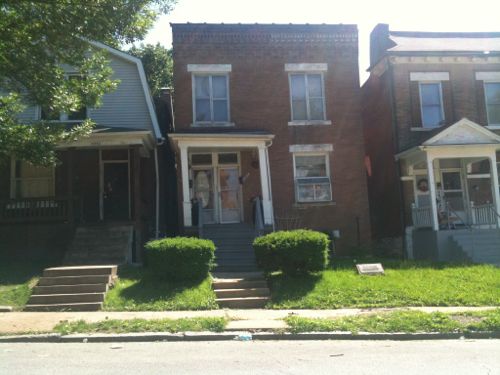Supreme Court Ruled on Restrictive Covenants 63 Years Ago Today

The modest house located at 4600 Labadie was at the center of a landmark U.S. Supreme Court ruling 63 years ago today:
In 1930, J. D. Shelley, his wife, and their six children migrated to St. Louis from Mississippi to escape the pervasive racial oppression of the South. For a number of years they lived with relatives and then in rental properties. In looking to buy a home, they found that many buildings in St. Louis were covered by racially restrictive covenants by which the building owners agreed not to sell to anyone other than a Caucasian. The Shelleys directly challenged this discriminatory practice by purchasing such a building at 4600 Labadie Avenue from an owner who agreed not to enforce the racial covenant. Louis D. Kraemer, owner of another property on Labadie covered by restrictive covenants, sued in the St. Louis Circuit (State) Court to enforce the restrictive covenant and prevent the Shelleys from acquiring title to the building. The trial court ruled in the Shelleys’ favor in November of 1945, but when Kraemer appealed, the Missouri Supreme Court, on December 9, 1946, reversed the trial court’s decision and ordered that the racial covenant be enforced. The Shelleys then appealed to the United States Supreme Court.
On May 3, 1948, the United States Supreme Court rendered its landmark decision in Shelley v. Kraemer, holding, by a vote of 6 to 0 (with three judges not sitting), that racially restrictive covenants cannot be enforced by courts since this would constitute state action denying due process of law in violation of the 14th Amendment to the Constitution. Although the case did not outlaw covenants (only a state’s enforcement of the practice), in Shelley v. Kraemer the Supreme Court reinforced strongly the 14th Amendment’s guarantee of equal protection of the laws, which includes rights to acquire, enjoy, own, and dispose of property. The Shelley case was a heartening signal for African Americans that positive social change could be achieved through law and the courts. (National Park Service)
I visited the block again last month and it is like many in North St. Louis: Â quiet with maintained homes but signs of flight. Â The house pictured on the left in the image above recently burned down, the remains razed.
Interesting, other African-American families lived on the block — predating the restrictive covenants. One family had lived on the street since the 19th century.
Hats off the the Shelley’s for fighting for years to stay in their home. No doubt the ruling prompted many white families to leave for other parts of the city and for the newly developing suburbs. It would be interesting to look at property records on this block to see when other houses were sold. Â Were the Kraemer’s the first? Did others leave before the court case was settled?
The Shelley house, built in 1906, is an owner-occupied private residence and is listed on the National Register of Historic Places. The neighborhood is currently identified as the “Greater Ville”, the Ville had been the center of African-American life in St. Louis for decades.
– Steve Patterson
Steve, are you familiar with “Mapping Decline: St. Louis and the Fate of the American City” by Colin Gordon? It’s worth a read.
Web-based companion project here: http://mappingdecline.lib.uiowa.edu/
Steve, are you familiar with “Mapping Decline: St. Louis and the Fate of the American City” by Colin Gordon? It’s worth a read.
Web-based companion project here: http://mappingdecline.lib.uiowa.edu/
JS, you absolutely read my mind. I was going to post the same site in response to this post. It’s really phenomenal.
Yes, I got a copy from Mr. Gordon personally when he spoke at East-West Gateway.
JS, you absolutely read my mind. I was going to post the same site in response to this post. It’s really phenomenal.
wow nice spotlight as well as additional info on the comments. i knew this was the case, but it is nice to see the detailed data.
wow nice spotlight as well as additional info on the comments. i knew this was the case, but it is nice to see the detailed data.
Yes, I got a copy from Mr. Gordon personally when he spoke at East-West Gateway.